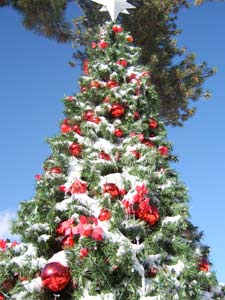Home Page » Post
« Next Article: don Quijote Salamanca students photo competition and accent the city!
» Previous Article: 2010 courses at 2009 prices!
Friday, October 23, 2009 (read 1695 times)
La Nochebuena
by Anthony Pemberton

As we're approaching the end of October we are well into the autumn season. At this time of year many people start to think and talk about the upcoming festivities of Christmas. In other countries the buzz of Christmas can be seen from the start of September as all the shops fill up with Christmas stock. However Christmas in Spain is very different as no trace of it is seen until the month in which it is celebrated, December. The shop windows in Spain are decorated with minimal effort being made and very few people decorate the window or balcony. The traditional Belén (Nativity scene) that is set up in most Spanish homes in place of a Christmas tree is not brought out until the second half of December. This is because Christmas in Spain is less commercialized and focuses more on family and true spirit of Christmas.
Also being a largely catholic country Christmas time in Spain holds lots of religious connotations. The Belén that is set up in houses is sometimes, in some cities of Spain, made real-life and the locals make live belenes using real people to play the roles of the Virgin Mary, Joseph, Balthazar, Melchior, Gaspar (The 3 Kings) and a real baby as the newborn Jesus. This symbolic representation is also carried out in parts of Latin America, for example Christmas in Mexico, the procession of Las Posadas (The search for an inn) can be seen through the streets re-enacted by the people of the town.
In Spain the traditional Christmas dinner takes place on the night of the Nochebuena or Christmas Eve. The Spanish consider it to be the biggest and most important meal of the year, hence celebrate the occasion in large family gatherings. The Spanish do not do things by halves preparing a feast is prepared with fish and shellfish usually as starters, then a roasted lamb or a suckling pig as the main, and this sometimes depends on the region. The dessert is a mix of delicacies consisting of the traditional mazapán (marzipan cakes), turrones (hard or soft almond based candy nougats) and polvorones (delicate "dusty " almond cookies). Spanish champagne or cava is typically drunk this time of year, but plenty of fine Spanish wines and ciders are also uncorked for the celebrations.
Christmas day itself is quite a low-key affair in Spain and the majority of businesses are closed. However there are a few that stay open, mainly restaurants or bars in which many Spanish eat on the 25th December. Adults exchange gifts on Christmas day whereas the children wait till the 6th January to get their presents from Los Tres Reyes Magos (The three Kings), with the exception of Catalan children who receive them from El Tio Nadal, a wooden log with a drawn on happy face.
Experiencing Christmas in Spain is a different experience and why not do it combined with a Christmas Spanish course to truly to get the most from Christmas!
Keywords: spanish,spain,navidad,food,fiesta,culture,christmas
